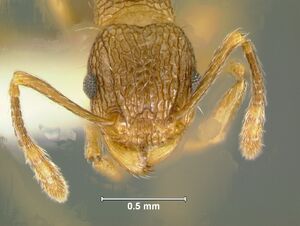Tetramorium rinatum
| Tetramorium rinatum | |
|---|---|

| |
| Scientific classification | |
| Kingdom: | Animalia |
| Phylum: | Arthropoda |
| Class: | Insecta |
| Order: | Hymenoptera |
| Family: | Formicidae |
| Subfamily: | Myrmicinae |
| Tribe: | Crematogastrini |
| Genus: | Tetramorium |
| Species: | T. rinatum |
| Binomial name | |
| Tetramorium rinatum Bolton, 1977 | |
Nothing is known about the biology of Tetramorium rinatum.
Identification
Bolton (1977) - T. rinatum is a quite ordinary member of the tortuosum-group and the characters given in the key should separate it from its known allies without difficulty; it is the only member of its group known to occur in the Philippines.
Distribution
Latitudinal Distribution Pattern
Latitudinal Range: 9.316667° to 9.316667°.
| North Temperate |
North Subtropical |
Tropical | South Subtropical |
South Temperate |
- Source: AntMaps
Distribution based on Regional Taxon Lists
Indo-Australian Region: Philippines (type locality).
Distribution based on AntMaps
Distribution based on AntWeb specimens
Check data from AntWeb
Countries Occupied
| Number of countries occupied by this species based on AntWiki Regional Taxon Lists. In general, fewer countries occupied indicates a narrower range, while more countries indicates a more widespread species. |

|
Estimated Abundance
| Relative abundance based on number of AntMaps records per species (this species within the purple bar). Fewer records (to the left) indicates a less abundant/encountered species while more records (to the right) indicates more abundant/encountered species. |

|
Biology
Castes
Worker
   
| |
| . | Owned by Museum of Comparative Zoology. |
Nomenclature
The following information is derived from Barry Bolton's Online Catalogue of the Ants of the World.
- rinatum. Tetramorium rinatum Bolton, 1977: 82, fig. 11 (w.) PHILIPPINES.
Unless otherwise noted the text for the remainder of this section is reported from the publication that includes the original description.
A number of other specimens of this species are in the Chapman collection housed at MCZ, Cambridge, but are in poor condition. Also there is a single specimen from Taiwan (= Formosa) collected by L. Gressitt which may belong to this species or be a closely related new species. As only one specimen is available I am unable to say at the present time.
Description
Worker
Holotype. TL 3.2, HL 0.76, HW 0.66, CI 87, SL 0.68, SI 103, PW 0.50, AL 0.90.
Mandibles striate. Frontal carinae well developed anteriorly but behind the level of the eyes becoming weaker until indistinguishable from the reticulate-rugulose sculpture on the posterior portion of the head. Antennal scapes relatively long, SI 100 or more. Propodeal spines of moderate length, narrow and acute, the metapleural lobes triangular, acute and somewhat upcurved. Petiole node in profile low and long, the ventral surface of the peduncle and node convex through most of its length (Fig. 11). In dorsal view the petiole node slightly longer than broad, narrowest in front and broadening posteriorly. Dorsal surfaces of head and alitrunk everywhere finely reticulate-rugulose, dorsal surfaces of petiole and postpetiole with only the faintest traces of sculpture, almost completely smooth. Sides of petiole with some rugulose sculpture. Gaster unsculptured. All dorsal surfaces of head and body with numerous elongate, fine hairs. Colour uniform yellowish brown.
Paratype. TL 3.0-3.3, HL 0.76-0.80, HW 0.64-0.70, CI 84-87, SL 0.66-0.70, SI 100-103, PW 0.46-0.52, AL 0.86-0.92 (7 measured).
As holotype but some specimens slightly darker in colour.
Type Material
Holotype worker, Philippines (PI on label): Dumaguete, 6.iv.27 (J. W. Chapman) (Museum of Comparative Zoology). Paratypes. Philippines: 3 workers with same data as holotype; 4 workers, Dumaguete, Camp 4, 2.iv.31 (J. W. Chapman) (MCZC; The Natural History Museum).
References
References based on Global Ant Biodiversity Informatics
- Bolton B. 1977. The ant tribe Tetramoriini (Hymenoptera: Formicidae). The genus Tetramorium Mayr in the Oriental and Indo-Australian regions, and in Australia. Bulletin of the British Museum (Natural History). Entomology 36:67-151.
- Bolton, B. "The ant tribe Tetramoriini (Hymenoptera: Formicinae. The genus Tetramorium Mayr in the Oriental and Indo-Australian regions and in Australia." Bulletin of the British Museum (National History): Entomology series 36, no. 2 (1977): 68-151.

